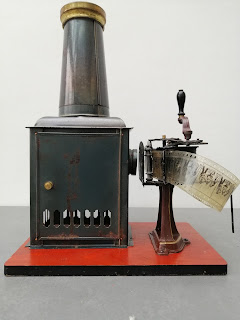Deze ´cinématographe´ komt uit Frankrijk en draagt de naam L´Eureka Cinématographe. Gemaakt of verdeeld door K.B. Paris. Hij dateert uit ongeveer 1900.
This ´cinématographe´ comes from France and is called L´Eureka Cinématographe. Made or distributed by K.B. Paris. It dates from around 1900.
Kratz Boussac (George Carette?)
Op de toverlantaarn zelf staan geen initialen van een maker, enkel op het papiertje met de gebruiksinstructies (K.B. Paris). K.B. Paris staat voor Etablissements Kratz Boussac. In een catalogus uit 1900 die terug te vinden is op de website van François Binetruy, zien we dezelfde projector geadverteerd.
De projector is echter identiek aan een projector uitgebracht door de Duitse fabrikant George Carette. Het is dus mogelijk dat de projector gemaakt is door Carette speciaal voor de export, dus zonder eigen merkteken of initialen. Zo kon de projector in Frankrijk door iemand anders verdeeld en verkocht worden onder een andere naam.
Kratz Boussac (George Carette?)
There are no maker's initials on the magic lantern itself, only on the instruction sheet that came with the projector (K.B. Paris). K.B. Paris stands for Etablissements Kratz - Boussac. In a 1900 catalogue that can be found on François Binetruy's website, the same projector is advertised.
However, the projector is identical to a projector produced by the German manufacturer George Carette. It is possible that the projector was made by Carette especially for export, without his own brand or initials. This way, the projector could be distributed and sold in France by someone else.
De toverlantaarn kan lantaarnplaatjes projecteren of korte animaties op een 35mm filmstrip. Het mechanisme om de animaties te projecteren, gebruikt een maltees kruis. Wat deze projector bijzonder maakt is dat de film horizontaal door de projector loopt. De meeste filmprojectors laten de film verticaal door de projector lopen.
Omdat de film horizontaal loopt, zijn de afbeeldingen op de film verticaal ingetekend. We krijgen een rechtopstaand beeld te zien (portret stand) in plaats van een liggend beeld.
The magic lantern can project lantern slides or short animations on a 35mm filmstrip. The mechanism for projecting the animations uses a maltese cross. What makes this projector special is that the film runs horizontally through the projector. Most film projectors have the film run vertically through the projector.
Because the film runs horizontally, the images on the film are drawn vertically. We get to see an upright image (portrait mode) instead of a landscape image.
De lantaarn heeft zijn originele doos, maar die is behoorlijk beschadigd. Verder zaten er enkele filmstrips en een aantal lantaarnplaatsjes bij. De originele handleiding was ook aanwezig. De petrolium lamp ontbrak jammer genoeg.
The lantern has its original box, but it is quite damaged. Also included were some film strips and some lantern slides. The original manual was also present. The petrolium lamp was unfortunately missing.





